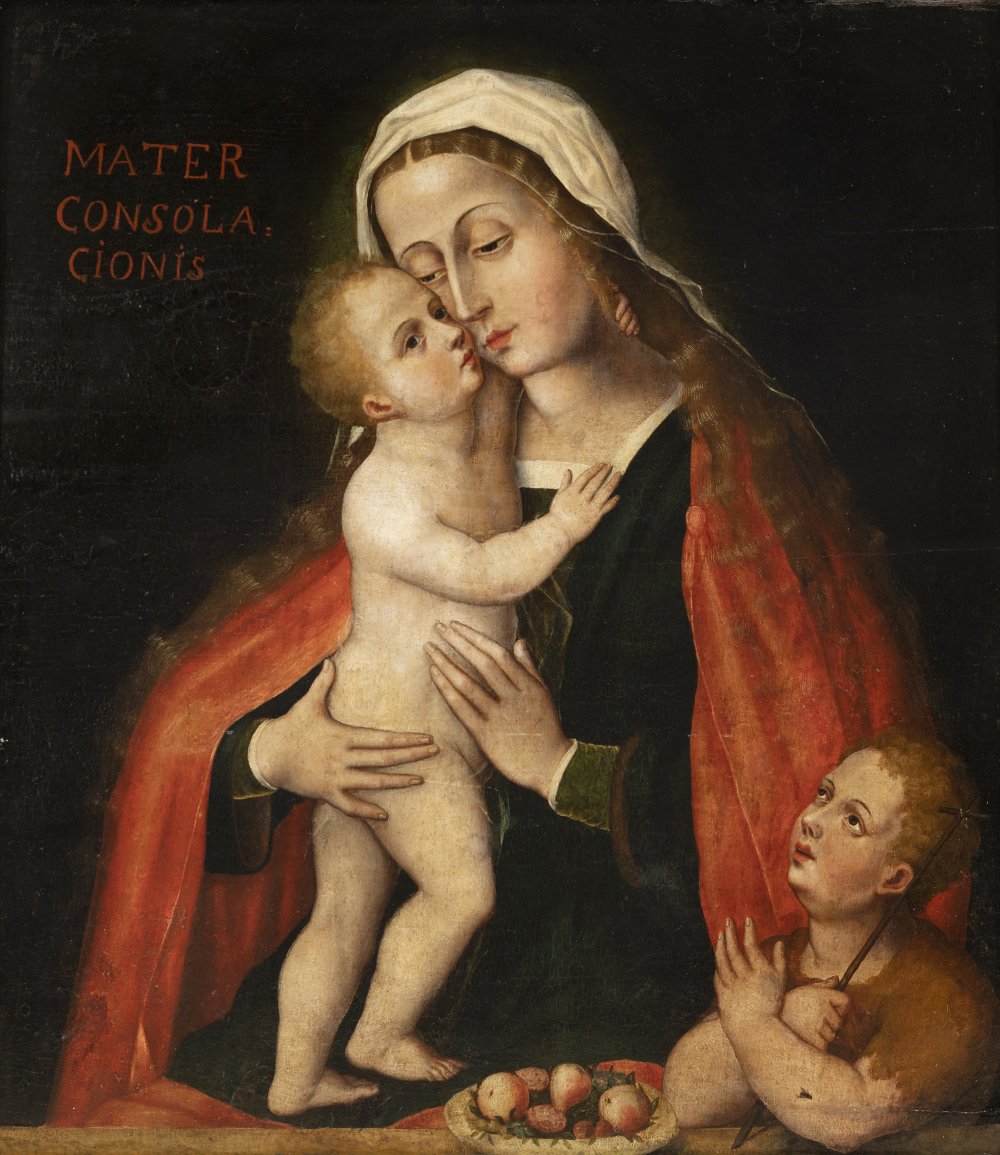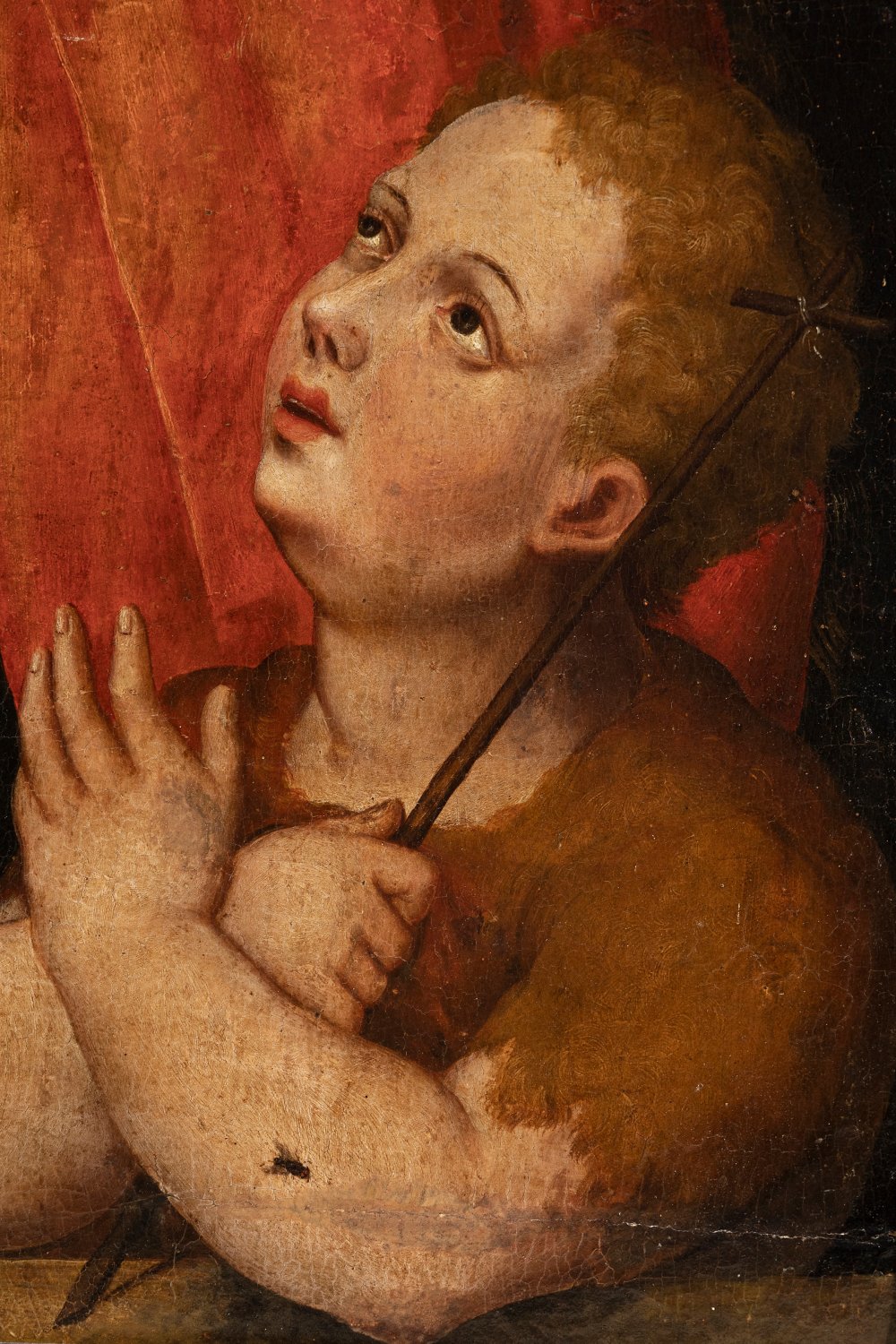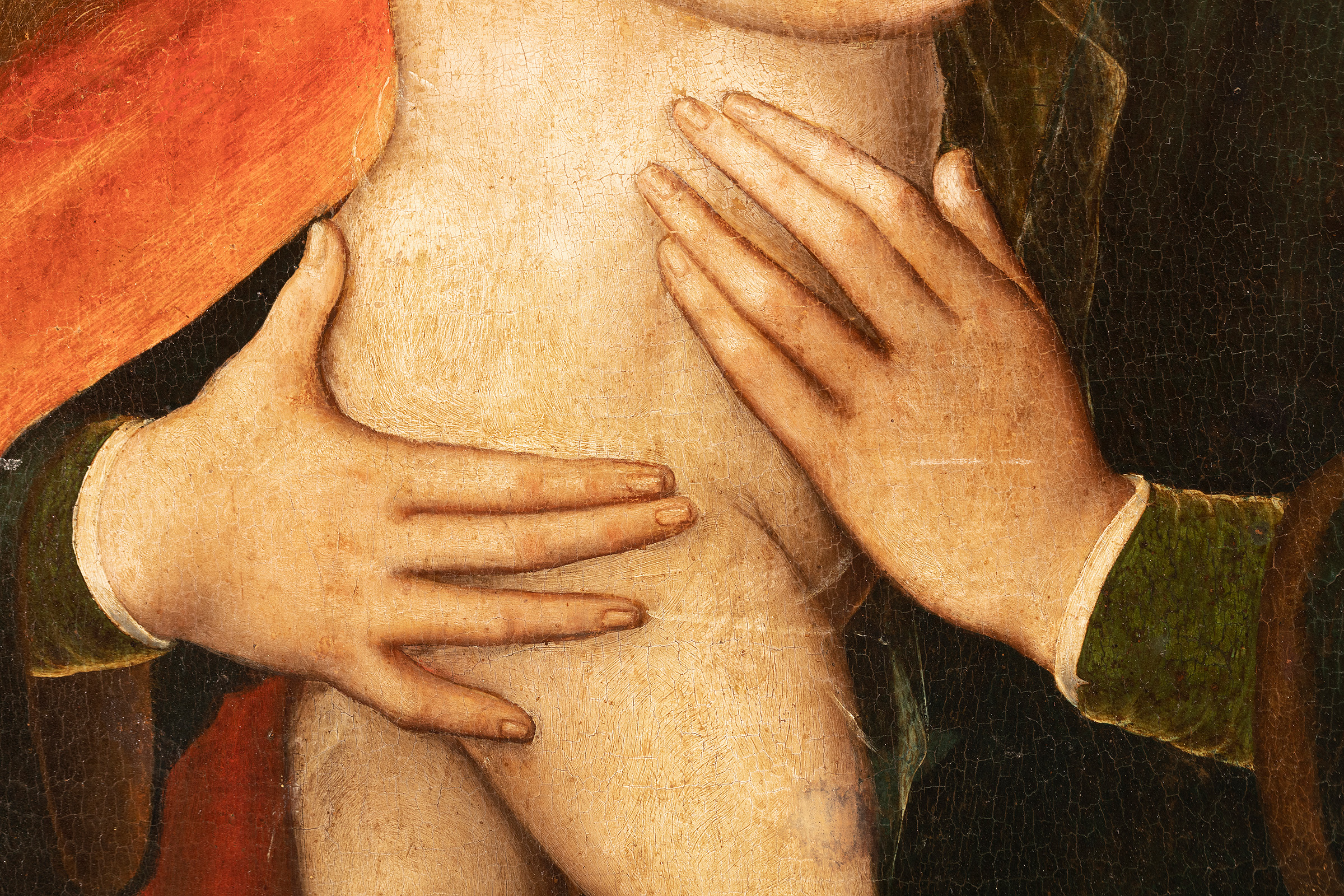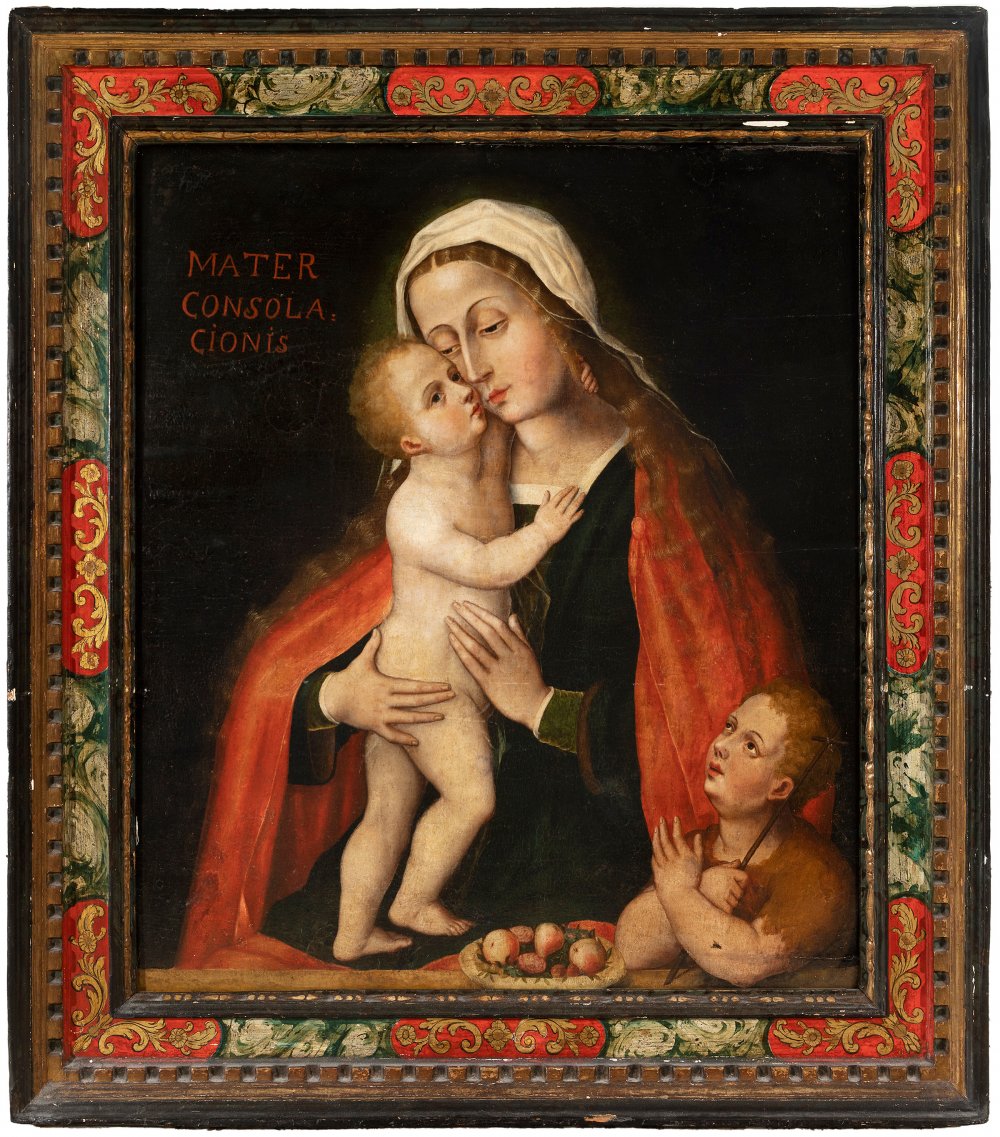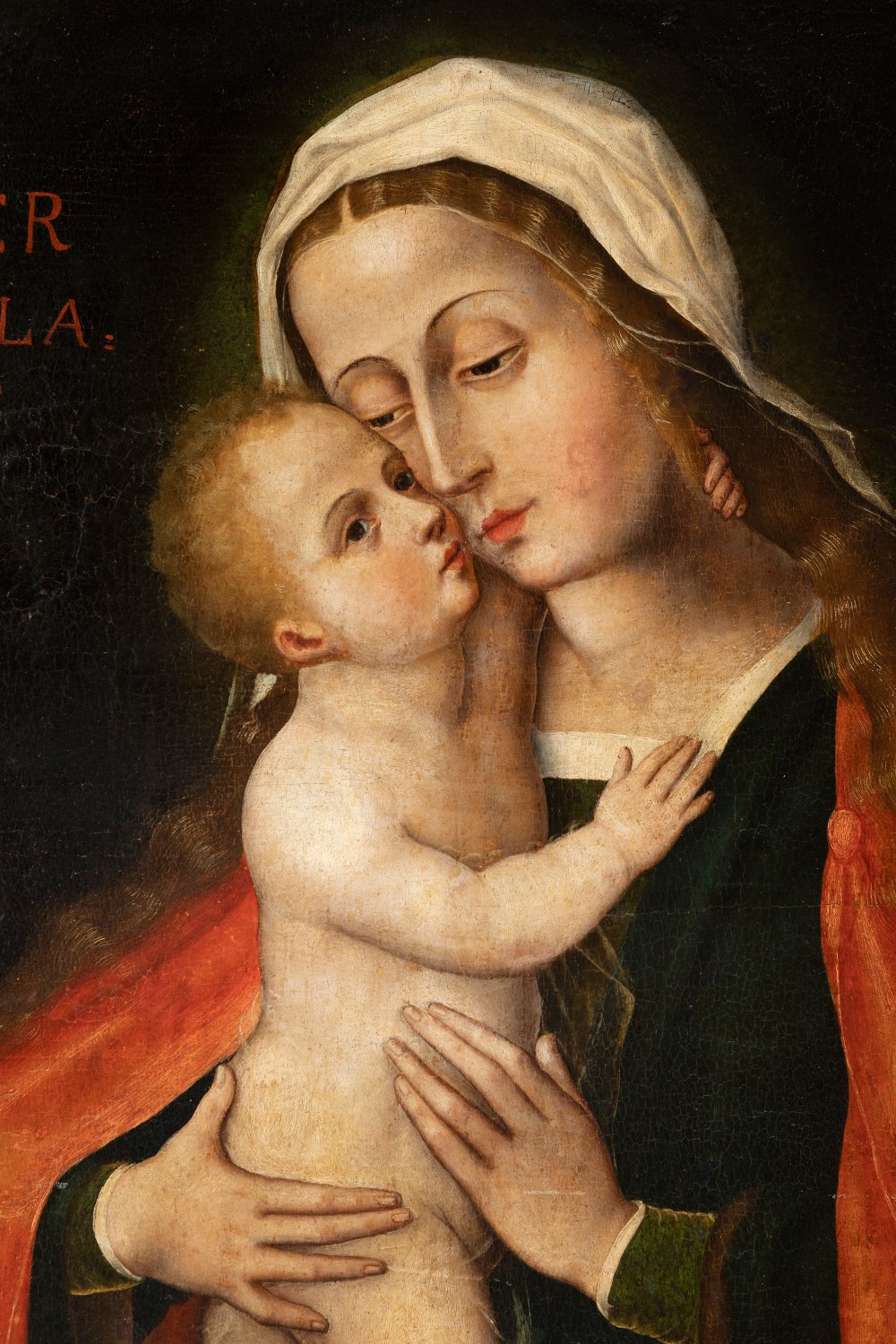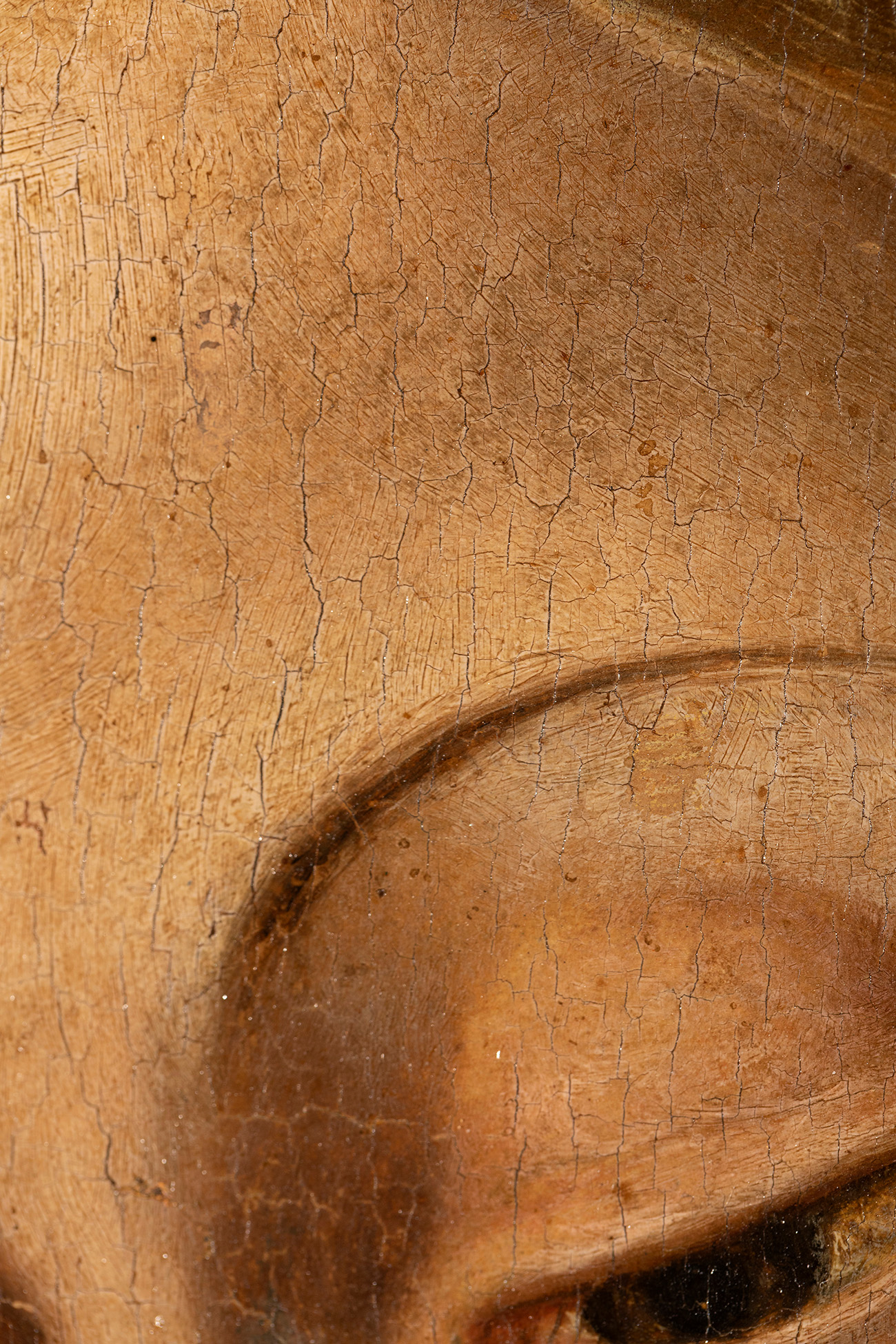11
Follower of AMBROSIUS BENSON (Lombardy?, ca.1490-1500 - Bruges, 1550), 16th century."Madonna and
1/7
Description
Follower of AMBROSIUS BENSON (Lombardy?, ca.1490-1500 - Bruges, 1550), 16th century.
"Madonna and Child with Saint John Child.
Oil on panel.
Size: 78 x 69 cm; 100 x 89 cm (frame).
The present painting, of extreme refinement, is modelled on "The Virgin and Child" (ca.1530) attributed to Ambrosius Benson, now in the Museo de Bellas Artes in Seville, who in turn was inspired by paintings by Roger van der Weyden. It therefore belongs to the Bruges school of the Renaissance period. The Flemish panel depicts a young Mary with golden hair. She is seated three-quarter length and the Christ Child embraces her, standing on her lap. The tender maternal-filial embrace and the exchange of glances between the three figures (including the Infant Saint John the Baptist, who does not appear in Benson's painting) are defined here by their great plastic subtlety. The faces of mother and son brush against each other and their lipsticked mouths almost kiss. The half-closed eyelids of the Virgin leave a groove of candid gaze. Jesus' eyes, also black, glow with similar intensity and his naked flesh seems to contain light within. A faint glow lights up the cheeks of the three figures. The long-fingered hands speak for themselves through gestural dramaturgy. Mary's wavy hair falls in long waves, resembling the smoothness of silk. The red cloak contrasts with the whiteness of her skin and the dark velvet robe. A basket of fruit, which expresses the interest of Flemish painting in still life, is also symbolic. Another characteristic detail of Flemish work is the introduction of everyday aspects, exemplified on this occasion by the fly perched on Juanito's arm. Immediacy and eternity are not at odds.
Ambrosius Benson was a Flemish painter of presumably Italian origin, father of the painters and pupils Guillaume and Jan Benson. In 1518 he became a citizen of Bruges and worked for a period in the studio of Gerard David. In 1519 he was already registered with the Painters' Guild as an independent master. From 1520 onwards Benson's workshop saw an increase in production and between 1522 and 1530 he rented between one and three stalls at the market each year to sell his paintings. We also know the names of two of his apprentices, Joachim Spaers and Jacob Vinson. Two of his sons, Willen and Jan Benson, were also painters and probably collaborated with him. Benson held high positions in the Painters' Guild. He bought a house from the Spanish merchant Lucas de Castro. Only two signed works by Benson are known, Triptych of Saint Anthony of Padua (Musées Royaux des Beaux-Arts de Belgique, Brussels) and The Holy Family (private collection), and seven dated works, but on the basis of stylistic criteria over 150 paintings have been attributed to him. The earliest are Portrait of a Man (Philadelphia Museum of Art, The John G. Johnson Collection, Philadelphia), The Holy Family with Saint John and Descent from the Cross (Segovia cathedral). Benson's workshop had an important production, generally destined for the Iberian market. A certain Sancho de Santander appears regularly in documentation relating to Benson and probably played an important role in the export of his works. His painting was highly appreciated in Spain and had a large following despite the fact that he was never in the country. Together with Adriaen Isenbrandt and Jan Provost he was one of the last generation of Bruges painters to break with the Gothic tradition and introduce the innovations of the Italian Renaissance into their style. This influence is evident in the artist's style and monumental effects, while the subjects and composition remain in the Flemish tradition.
"Madonna and Child with Saint John Child.
Oil on panel.
Size: 78 x 69 cm; 100 x 89 cm (frame).
The present painting, of extreme refinement, is modelled on "The Virgin and Child" (ca.1530) attributed to Ambrosius Benson, now in the Museo de Bellas Artes in Seville, who in turn was inspired by paintings by Roger van der Weyden. It therefore belongs to the Bruges school of the Renaissance period. The Flemish panel depicts a young Mary with golden hair. She is seated three-quarter length and the Christ Child embraces her, standing on her lap. The tender maternal-filial embrace and the exchange of glances between the three figures (including the Infant Saint John the Baptist, who does not appear in Benson's painting) are defined here by their great plastic subtlety. The faces of mother and son brush against each other and their lipsticked mouths almost kiss. The half-closed eyelids of the Virgin leave a groove of candid gaze. Jesus' eyes, also black, glow with similar intensity and his naked flesh seems to contain light within. A faint glow lights up the cheeks of the three figures. The long-fingered hands speak for themselves through gestural dramaturgy. Mary's wavy hair falls in long waves, resembling the smoothness of silk. The red cloak contrasts with the whiteness of her skin and the dark velvet robe. A basket of fruit, which expresses the interest of Flemish painting in still life, is also symbolic. Another characteristic detail of Flemish work is the introduction of everyday aspects, exemplified on this occasion by the fly perched on Juanito's arm. Immediacy and eternity are not at odds.
Ambrosius Benson was a Flemish painter of presumably Italian origin, father of the painters and pupils Guillaume and Jan Benson. In 1518 he became a citizen of Bruges and worked for a period in the studio of Gerard David. In 1519 he was already registered with the Painters' Guild as an independent master. From 1520 onwards Benson's workshop saw an increase in production and between 1522 and 1530 he rented between one and three stalls at the market each year to sell his paintings. We also know the names of two of his apprentices, Joachim Spaers and Jacob Vinson. Two of his sons, Willen and Jan Benson, were also painters and probably collaborated with him. Benson held high positions in the Painters' Guild. He bought a house from the Spanish merchant Lucas de Castro. Only two signed works by Benson are known, Triptych of Saint Anthony of Padua (Musées Royaux des Beaux-Arts de Belgique, Brussels) and The Holy Family (private collection), and seven dated works, but on the basis of stylistic criteria over 150 paintings have been attributed to him. The earliest are Portrait of a Man (Philadelphia Museum of Art, The John G. Johnson Collection, Philadelphia), The Holy Family with Saint John and Descent from the Cross (Segovia cathedral). Benson's workshop had an important production, generally destined for the Iberian market. A certain Sancho de Santander appears regularly in documentation relating to Benson and probably played an important role in the export of his works. His painting was highly appreciated in Spain and had a large following despite the fact that he was never in the country. Together with Adriaen Isenbrandt and Jan Provost he was one of the last generation of Bruges painters to break with the Gothic tradition and introduce the innovations of the Italian Renaissance into their style. This influence is evident in the artist's style and monumental effects, while the subjects and composition remain in the Flemish tradition.
Auction Details
Shipping
T&Cs & Important Info
Ask seller a question
Follower of AMBROSIUS BENSON (Lombardy?, ca.1490-1500 - Bruges, 1550), 16th century.
"Madonna and Child with Saint John Child.
Oil on panel.
Size: 78 x 69 cm; 100 x 89 cm (frame).
The present painting, of extreme refinement, is modelled on "The Virgin and Child" (ca.1530) attributed to Ambrosius Benson, now in the Museo de Bellas Artes in Seville, who in turn was inspired by paintings by Roger van der Weyden. It therefore belongs to the Bruges school of the Renaissance period. The Flemish panel depicts a young Mary with golden hair. She is seated three-quarter length and the Christ Child embraces her, standing on her lap. The tender maternal-filial embrace and the exchange of glances between the three figures (including the Infant Saint John the Baptist, who does not appear in Benson's painting) are defined here by their great plastic subtlety. The faces of mother and son brush against each other and their lipsticked mouths almost kiss. The half-closed eyelids of the Virgin leave a groove of candid gaze. Jesus' eyes, also black, glow with similar intensity and his naked flesh seems to contain light within. A faint glow lights up the cheeks of the three figures. The long-fingered hands speak for themselves through gestural dramaturgy. Mary's wavy hair falls in long waves, resembling the smoothness of silk. The red cloak contrasts with the whiteness of her skin and the dark velvet robe. A basket of fruit, which expresses the interest of Flemish painting in still life, is also symbolic. Another characteristic detail of Flemish work is the introduction of everyday aspects, exemplified on this occasion by the fly perched on Juanito's arm. Immediacy and eternity are not at odds.
Ambrosius Benson was a Flemish painter of presumably Italian origin, father of the painters and pupils Guillaume and Jan Benson. In 1518 he became a citizen of Bruges and worked for a period in the studio of Gerard David. In 1519 he was already registered with the Painters' Guild as an independent master. From 1520 onwards Benson's workshop saw an increase in production and between 1522 and 1530 he rented between one and three stalls at the market each year to sell his paintings. We also know the names of two of his apprentices, Joachim Spaers and Jacob Vinson. Two of his sons, Willen and Jan Benson, were also painters and probably collaborated with him. Benson held high positions in the Painters' Guild. He bought a house from the Spanish merchant Lucas de Castro. Only two signed works by Benson are known, Triptych of Saint Anthony of Padua (Musées Royaux des Beaux-Arts de Belgique, Brussels) and The Holy Family (private collection), and seven dated works, but on the basis of stylistic criteria over 150 paintings have been attributed to him. The earliest are Portrait of a Man (Philadelphia Museum of Art, The John G. Johnson Collection, Philadelphia), The Holy Family with Saint John and Descent from the Cross (Segovia cathedral). Benson's workshop had an important production, generally destined for the Iberian market. A certain Sancho de Santander appears regularly in documentation relating to Benson and probably played an important role in the export of his works. His painting was highly appreciated in Spain and had a large following despite the fact that he was never in the country. Together with Adriaen Isenbrandt and Jan Provost he was one of the last generation of Bruges painters to break with the Gothic tradition and introduce the innovations of the Italian Renaissance into their style. This influence is evident in the artist's style and monumental effects, while the subjects and composition remain in the Flemish tradition.
"Madonna and Child with Saint John Child.
Oil on panel.
Size: 78 x 69 cm; 100 x 89 cm (frame).
The present painting, of extreme refinement, is modelled on "The Virgin and Child" (ca.1530) attributed to Ambrosius Benson, now in the Museo de Bellas Artes in Seville, who in turn was inspired by paintings by Roger van der Weyden. It therefore belongs to the Bruges school of the Renaissance period. The Flemish panel depicts a young Mary with golden hair. She is seated three-quarter length and the Christ Child embraces her, standing on her lap. The tender maternal-filial embrace and the exchange of glances between the three figures (including the Infant Saint John the Baptist, who does not appear in Benson's painting) are defined here by their great plastic subtlety. The faces of mother and son brush against each other and their lipsticked mouths almost kiss. The half-closed eyelids of the Virgin leave a groove of candid gaze. Jesus' eyes, also black, glow with similar intensity and his naked flesh seems to contain light within. A faint glow lights up the cheeks of the three figures. The long-fingered hands speak for themselves through gestural dramaturgy. Mary's wavy hair falls in long waves, resembling the smoothness of silk. The red cloak contrasts with the whiteness of her skin and the dark velvet robe. A basket of fruit, which expresses the interest of Flemish painting in still life, is also symbolic. Another characteristic detail of Flemish work is the introduction of everyday aspects, exemplified on this occasion by the fly perched on Juanito's arm. Immediacy and eternity are not at odds.
Ambrosius Benson was a Flemish painter of presumably Italian origin, father of the painters and pupils Guillaume and Jan Benson. In 1518 he became a citizen of Bruges and worked for a period in the studio of Gerard David. In 1519 he was already registered with the Painters' Guild as an independent master. From 1520 onwards Benson's workshop saw an increase in production and between 1522 and 1530 he rented between one and three stalls at the market each year to sell his paintings. We also know the names of two of his apprentices, Joachim Spaers and Jacob Vinson. Two of his sons, Willen and Jan Benson, were also painters and probably collaborated with him. Benson held high positions in the Painters' Guild. He bought a house from the Spanish merchant Lucas de Castro. Only two signed works by Benson are known, Triptych of Saint Anthony of Padua (Musées Royaux des Beaux-Arts de Belgique, Brussels) and The Holy Family (private collection), and seven dated works, but on the basis of stylistic criteria over 150 paintings have been attributed to him. The earliest are Portrait of a Man (Philadelphia Museum of Art, The John G. Johnson Collection, Philadelphia), The Holy Family with Saint John and Descent from the Cross (Segovia cathedral). Benson's workshop had an important production, generally destined for the Iberian market. A certain Sancho de Santander appears regularly in documentation relating to Benson and probably played an important role in the export of his works. His painting was highly appreciated in Spain and had a large following despite the fact that he was never in the country. Together with Adriaen Isenbrandt and Jan Provost he was one of the last generation of Bruges painters to break with the Gothic tradition and introduce the innovations of the Italian Renaissance into their style. This influence is evident in the artist's style and monumental effects, while the subjects and composition remain in the Flemish tradition.
29th December - Old Masters
Sale Date(s)
Venue Address
Aragón 346, Barcelona
Calle Velázquez 7, Madrid
Carrer de Cirilo Amorós 55, Valencia
Barcelona
08009
Spain
General delivery information available from the auctioneer
Setdart offers Worldwide shipping
PICK UP IN ROOM: You can come and pick up your lots in our offices (Barcelona, Madrid or Valencia). At the moment of the withdrawal, you will be able to accept the current conditions of the lot by means of a document that you will sign.
YOU CAN SEND ANOTHER PERSON TO PICK UP: This person must present a signed authorization that you can find in our web page by accessing from BUY AT SETDART- LOGISTICS-DOWNLOAD AUTHORIZATION DOCUMENT. You can also send an e-mail with the requested data in AUTHORIZATION DOCUMENT to admin@setdart.com
Important Information
25% buyer´s premium
21% buyer´s premium at www.setdart.com















